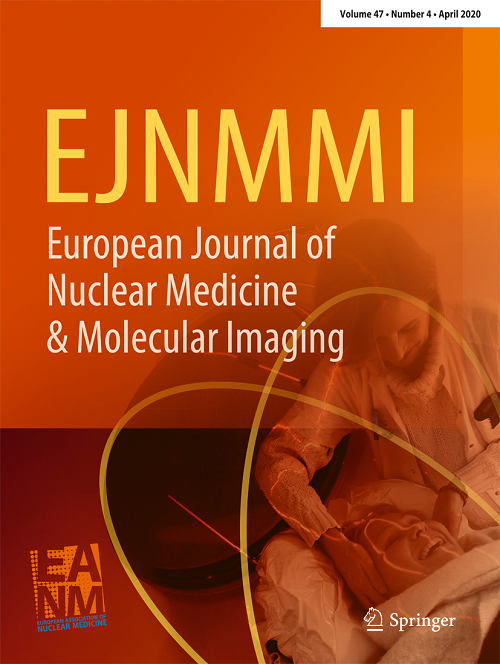一种新的胆固醇24-羟化酶PET配体[18F]CHL2310在非人灵长类脑中的定量分析。
IF 7.6
1区 医学
Q1 RADIOLOGY, NUCLEAR MEDICINE & MEDICAL IMAGING
European Journal of Nuclear Medicine and Molecular Imaging
Pub Date : 2025-10-01
DOI:10.1007/s00259-025-07547-x
引用次数: 0
摘要
胆固醇24-羟化酶(CYP46A1)是一种脑特异性酶,可催化胆固醇转化为24s -羟基胆固醇,在维持大脑胆固醇稳态中起关键作用。该通路的失调与各种神经系统疾病有关,包括阿尔茨海默病、亨廷顿病、癫痫和抑郁症。为了能够定量评估CYP46A1在体内的活性,我们设想了一种高特异性和良好药代动力学的靶向CYP46A1的PET放射性示踪剂。本研究旨在评估一种新型CYP46A1 PET放射配体[18F]CHL2310在非人灵长类动物中的代谢稳定性、靶特异性和药代动力学特性。方法采用甲磺酸前体合成CHL2310 [18F]。在非人类灵长类动物中进行基线和TAK-935预阻断PET成像,并进行动脉血液采样。全血和血浆放射性、血浆游离分数和代谢物分析生成代谢物校正的血浆输入函数。区域脑时间-活动曲线拟合采用单组织室模型、双组织室模型和Logan图形分析估计总分布体积。采用Lassen图量化TAK-935对CYP46A1的占用,从而评估剂量-占用关系。不可置换结合电位的计算使用不可置换分布体积或小脑作为参考区域。在同一受试者的基线扫描中评估测试-重测变异性。此外,对雄性和雌性猴子进行全身PET成像以估计人体辐射剂量。结果[18F]合成的CHL2310的放射化学产率为6.7±1.5%,放射化学纯度为bbb99 %。该示踪剂在NHP脑内具有较高的特异性结合,代谢稳定性良好,血浆游离率为13.1±0.8%。两组织间室模型和Logan图形分析很好地描述了tac。TAK-935表现出剂量依赖性CYP46A1占用,半最大抑制剂量为0.0095 mg/kg,来自Lassen图。组织分布体积的平均重测变异性为-3.0±4.8%,平均绝对TRV为4.4±3.5%。人体的有效辐射剂量估计为0.013毫西弗/MBq。结论[18F]CHL2310在非人灵长类动物中具有较高的体内特异性、良好的药代动力学特性和较强的定量性能。这些特征支持其作为PET放射性示踪剂在人体研究中成像CYP46A1的潜力。本文章由计算机程序翻译,如有差异,请以英文原文为准。
Quantitative analysis of [18F]CHL2310, a novel PET ligand for cholesterol 24-Hydroxylase, in nonhuman primate brain.
PURPOSE
Cholesterol 24-hydroxylase (CYP46A1) is a brain-specific enzyme catalyzes the conversion of cholesterol into 24S-hydroxycholesterol, thereby playing a pivotal role in maintaining cerebral cholesterol homeostasis. Dysregulation of this pathway has been implicated in various neurological disorders, including Alzheimer's disease, Huntington's disease, epilepsy, and depression. To enable quantitative assessment of CYP46A1 activity in vivo, a CYP46A1-targeted PET radiotracer with high specificity and favorable pharmacokinetics is envisioned. This study aimed to evaluate the metabolic stability, target specificity, and pharmacokinetic properties of [18F]CHL2310, a novel CYP46A1 PET radioligand, in non-human primates.
METHODS
[18F]CHL2310 was synthesized using a tosylate precursor. Baseline and TAK-935 pre-blocked PET imaging with arterial blood sampling were performed in non-human primates. Whole-blood and plasma radioactivity, plasma free fraction, and metabolite analysis were conducted to generate metabolite-corrected plasma input functions. Regional brain time-activity curves were fitted using one-tissue compartment model, two-tissue compartment model and Logan graphical analysis to estimate total distribution volume. CYP46A1 occupancy by TAK-935 was quantified using Lassen plots, enabling the assessment of the dose-occupancy relationship. Non-displaceable binding potential was calculated using either non-displaceable distribution volume or the cerebellum as a reference region. Test-retest variability was evaluated in baseline scans from the same subject. Additionally, whole-body PET imaging was performed in male and female monkeys to estimate human radiation dosimetry.
RESULTS
[18F]CHL2310 was synthesized with a non-decay-corrected radiochemical yield of 6.7 ± 1.5% and radiochemical purity >99%. The tracer demonstrated high specific binding in NHP brain with reasonable metabolic stability and a free fraction of 13.1 ± 0.8% in plasma. TACs were well described by two-tissue compartment model and Logan graphical analysis. TAK-935 exhibited dose-dependent CYP46A1 occupancy with a half-maximal inhibitory dose of 0.0095 mg/kg, derived from Lassen plots. The averaged test-retest variability of tissue distribution volumes was -3.0 ± 4.8%, and the averaged absolute TRV was 4.4 ± 3.5%. The effective radiation dose for humans was estimated as 0.013 mSv/MBq.
CONCLUSION
[18F]CHL2310 shows high in vivo specificity, favorable pharmacokinetic properties, and robust quantitative performance in non-human primates. These characteristics support its potential as a PET radiotracer for imaging CYP46A1 in human studies.
求助全文
通过发布文献求助,成功后即可免费获取论文全文。
去求助
来源期刊
CiteScore
15.60
自引率
9.90%
发文量
392
审稿时长
3 months
期刊介绍:
The European Journal of Nuclear Medicine and Molecular Imaging serves as a platform for the exchange of clinical and scientific information within nuclear medicine and related professions. It welcomes international submissions from professionals involved in the functional, metabolic, and molecular investigation of diseases. The journal's coverage spans physics, dosimetry, radiation biology, radiochemistry, and pharmacy, providing high-quality peer review by experts in the field. Known for highly cited and downloaded articles, it ensures global visibility for research work and is part of the EJNMMI journal family.

 求助内容:
求助内容: 应助结果提醒方式:
应助结果提醒方式:


